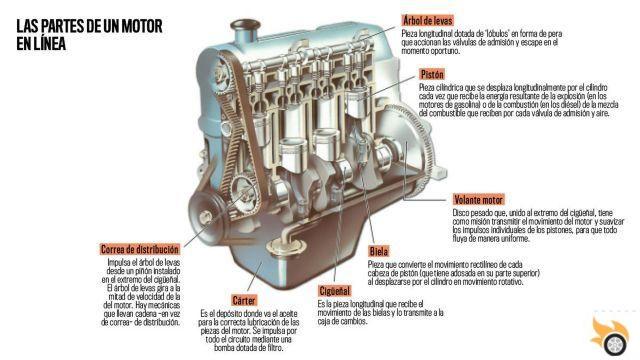
Introduction
Welcome to Pistonudos.com, where you will find all the information you need about car engines. In this article, we will provide you with a complete guide on the different parts and pieces of a car engine, as well as how it works and the different types that exist. If you are passionate about cars or just want to know more about how your vehicle works, keep reading!
parts of a car engine
A car engine is made up of various parts that work together to generate the power needed to keep the vehicle moving. Here are the most important parts of an engine:
engine block
The engine block is the main structure that houses all the other parts. It is generally made of cast iron or aluminum and contains the cylinders, crankshaft and crankcase.
Cylinders
The cylinders are the spaces where combustion occurs. Most car engines have between 4 and 8 cylinders, although there are engines with more cylinders in high-end vehicles. The cylinders are covered by shirts or shirts that reduce friction and wear.
Pistons
Pistons are moving parts that move inside cylinders. They are connected to the crankshaft via the connecting rods and their up and down movement generates the energy needed to move the vehicle.
Crankshaft
The crankshaft is a central part of the engine that converts the linear movement of the pistons into a rotary movement. It is connected to the pistons via the connecting rods and transmits the generated power to the vehicle's transmission system.
Camshaft
The camshaft is a part that controls the opening and closing of the intake and exhaust valves. It is connected to the crankshaft and its function is to ensure that the valves open and close at the right time to allow air and fuel to enter and exhaust gases to exit.
How a car engine works
The operation of a car engine is based on the four-stroke cycle, also known as the Otto cycle. This cycle consists of the following stages:
Admissions
At this stage, the intake valve opens and the piston moves down, allowing the air-fuel mixture to enter the cylinder.
Compression
Once the fuel-air mixture has entered the cylinder, the intake valve closes and the piston rises, compressing the mixture. This increases the pressure and temperature inside the cylinder.
Explosion
At this stage, the spark plug generates a spark that ignites the compressed fuel-air mixture. The resulting explosion forcefully pushes the piston down, generating the energy needed to move the vehicle.
Escape
Finally, the exhaust valve opens and the piston moves back up, expelling the exhaust gases produced by combustion. These gases are expelled through the vehicle's exhaust system.
types of car engines
There are different types of car engines, each with its own characteristics and advantages. Here are the most common types:
Internal combustion engine
The internal combustion engine is the most common type of car engine. It works by burning a mixture of air and fuel inside the cylinders. It can be gasoline or diesel, and is characterized by its efficiency and power.
Electric motor
Electric motors use electrical energy stored in batteries to generate movement. They are becoming increasingly popular due to their efficiency and lower environmental impact compared to internal combustion engines.
hybrid engine
Hybrid engines combine an internal combustion engine with one or more electric motors. This makes it possible to take advantage of both types of engines, offering greater efficiency and reducing polluting emissions.
rotary engine
The rotary engine, also known as a Wankel engine, is a type of internal combustion engine that uses rotors instead of pistons. It is characterized by its compact size and high power, but also by its higher fuel consumption.
Frequently Asked Questions (FAQs)
1. What is the difference between a gasoline engine and a diesel engine?
The main difference between a gasoline engine and a diesel engine lies in the type of fuel they use and in the combustion process. While a gasoline engine uses a gasoline-air mixture that is ignited by a spark generated by the spark plug, a diesel engine uses compressed air to ignite diesel fuel. This makes diesel engines more efficient in terms of fuel consumption, but also generates more polluting emissions.
2. What is the difference between an electric motor and an internal combustion engine?
The main difference between an electric motor and an internal combustion engine is the power source they use. While an electric motor uses electrical energy stored in batteries, an internal combustion engine uses the combustion of a mixture of air and fuel. Electric motors are more efficient and generate fewer polluting emissions, but have limited autonomy due to the capacity of the batteries.
Conclusion
In short, a car engine is made up of various parts that work together to generate the power needed to move the vehicle. Knowing the different parts and how they work will help you better understand how your car works and perform proper maintenance. In addition, there are different types of motors, each with its own characteristics and advantages. We hope this article has been useful and has provided you with the information you were looking for. If you have any additional questions, feel free to leave a comment below. We would love to hear your opinion!
Until next time!
The Pistonudos.com team


























